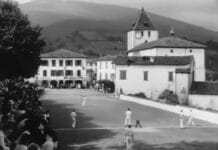On the anniversary of the birth of Basque composer Maurice Ravel, on March 7th, we had wanted to mark the occasion by bringing back two articles about this most universal Basque musician:
The one we wrote in 2011:
and the other we wrote in 2016:
But while looking for a little something more, we came across a spectacular and enlightening work about Ravel which meant we needed to pause in order to take it in, reference it, and share it with our readers.
The Basque Composer who Felt Basque
The author herself, Itxaso Sainz de la Maza Bilbao, summarizes the aims and conclusions of this work, which is the product of a thesis she wrote at the Superior Music School of Catalonia.
Ravel y Euskal Herria : influencias de la cultura vasca en un músico cosmopolita (Ravel and the Basque Country: Influences of the Basque Culture on a Cosmopolitan Musician)
This work came about from my personal desire to spread the knowledge of the close bond between Maurice Ravel and the Basque Country, as well as the way in which this phenomenon is present in his artistic creations. To that end, we will study, firstly, the relationship the composer had with Basque culture, and then we will analyze the different elements of this cultural reality (typical Basque musical instruments, traditional songs, dances, etc.) and the relationship they had with his work. We will therefore discover that Ravel was tightly linked with and influence by Basque culture and that, in essence, the same made up a fundamental peculiarity of who he was.
In this article, apart from delving, with greater depth, detail, and knowledge, into topics our two articles cover, she analyzes Ravel’s work, searching for, and finding, the presence of the elements of Basque music that are “hidden” in his notes and structures.
This work tells it all. Really, all we can add are a few points that we discuss in our articles that we think deserve to be highlighted again.
Maurice Ravel was born in Ziburu, or Ciboure in French, and that bit of information is usually unknown, or treated as an unimportant anecdote that has nothing to do with the career of this genius Frenchman. Few are aware that he spoke Basque. What’s more, whenever it’s mentioned that his mother was Basque, there’s always the tag that she came from a Spanish family, as if being Basque always meant being subrogated to something superior: being French or Spanish. At the most, they may ask what influence, if any, the popular Basque music his mother sang to him in his childhood may have had, while reminding all that he did not visit the land of his birth until he was 25.
Also, very little is said of his unfinished work, a great oeuvre titled “Zazpiak Bat” (out of many, one), dedicated to the Basques, which had to be abandoned when the First World War broke out. Nevertheless, what was finished left its mark on some of the composer’s other works, such as his “Trio for Piano, Violin, and Cello,” where it is easy to find the great influences of traditional Basque music.
Now, thanks to Itxaso Sainz de la Maza Bilbao, we know that another of his great works, the “Concerto for Piano in G Major,” has within it two elements of his unfinished “Basque Rhapsody for Piano and Orchestra, ‘Zazpiak Bat'”. In them, a spring morning in Ciboure and a festival in Maule are evoked.
In this concert, any ear attuned to Basque music will find many recognizable elements.
We strongly believe that this work deserves to be read in order to know, and understand, Maurice Ravel, or “Moriz” as he was nicknamed, as the Basque man and Basque composer that he was.
We will definitely not stop sharing this connection, especially because we’re doing nothing that he himself didn’t do: define himself as Basque.
The work of Itxaso Sainz de la Maza Bilbao, which we include here, can be found on Recercat
All that’s left is to thank this author for her magnificent study of a Basque composer, and hope that the original manuscript for “Zazpiak Bat,” which, as the author reminds us, is currently in a private collection, may soon be open to consultation by all researchers.
Automatic translation by Google (from English)
Last Updated on Dec 3, 2023 by About Basque Country






























